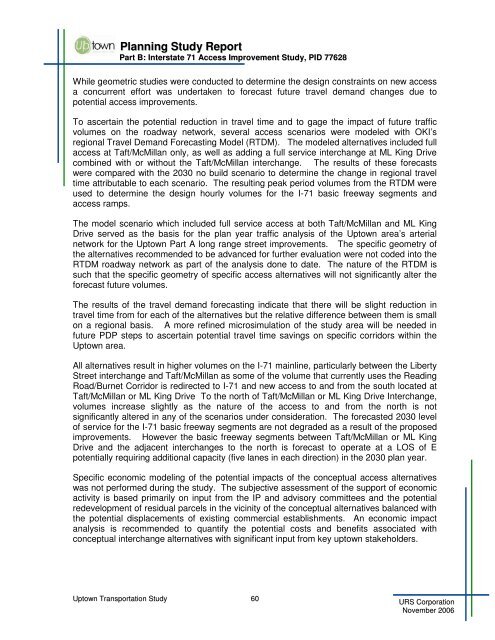Uptown Transportation Study - OKI
Uptown Transportation Study - OKI
Uptown Transportation Study - OKI
Create successful ePaper yourself
Turn your PDF publications into a flip-book with our unique Google optimized e-Paper software.
Planning <strong>Study</strong> ReportPart B: Interstate 71 Access Improvement <strong>Study</strong>, PID 77628While geometric studies were conducted to determine the design constraints on new accessa concurrent effort was undertaken to forecast future travel demand changes due topotential access improvements.To ascertain the potential reduction in travel time and to gage the impact of future trafficvolumes on the roadway network, several access scenarios were modeled with <strong>OKI</strong>’sregional Travel Demand Forecasting Model (RTDM). The modeled alternatives included fullaccess at Taft/McMillan only, as well as adding a full service interchange at ML King Drivecombined with or without the Taft/McMillan interchange. The results of these forecastswere compared with the 2030 no build scenario to determine the change in regional traveltime attributable to each scenario. The resulting peak period volumes from the RTDM wereused to determine the design hourly volumes for the I-71 basic freeway segments andaccess ramps.The model scenario which included full service access at both Taft/McMillan and ML KingDrive served as the basis for the plan year traffic analysis of the <strong>Uptown</strong> area’s arterialnetwork for the <strong>Uptown</strong> Part A long range street improvements. The specific geometry ofthe alternatives recommended to be advanced for further evaluation were not coded into theRTDM roadway network as part of the analysis done to date. The nature of the RTDM issuch that the specific geometry of specific access alternatives will not significantly alter theforecast future volumes.The results of the travel demand forecasting indicate that there will be slight reduction intravel time from for each of the alternatives but the relative difference between them is smallon a regional basis. A more refined microsimulation of the study area will be needed infuture PDP steps to ascertain potential travel time savings on specific corridors within the<strong>Uptown</strong> area.All alternatives result in higher volumes on the I-71 mainline, particularly between the LibertyStreet interchange and Taft/McMillan as some of the volume that currently uses the ReadingRoad/Burnet Corridor is redirected to I-71 and new access to and from the south located atTaft/McMillan or ML King Drive To the north of Taft/McMillan or ML King Drive Interchange,volumes increase slightly as the nature of the access to and from the north is notsignificantly altered in any of the scenarios under consideration. The forecasted 2030 levelof service for the I-71 basic freeway segments are not degraded as a result of the proposedimprovements. However the basic freeway segments between Taft/McMillan or ML KingDrive and the adjacent interchanges to the north is forecast to operate at a LOS of Epotentially requiring additional capacity (five lanes in each direction) in the 2030 plan year.Specific economic modeling of the potential impacts of the conceptual access alternativeswas not performed during the study. The subjective assessment of the support of economicactivity is based primarily on input from the IP and advisory committees and the potentialredevelopment of residual parcels in the vicinity of the conceptual alternatives balanced withthe potential displacements of existing commercial establishments. An economic impactanalysis is recommended to quantify the potential costs and benefits associated withconceptual interchange alternatives with significant input from key uptown stakeholders.<strong>Uptown</strong> <strong>Transportation</strong> <strong>Study</strong> 60URS CorporationNovember 2006
















